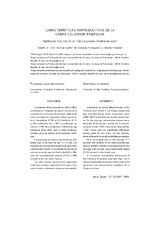Características reproductivas de la cabra Colorada Pampeana
Reproductive traits of the Colorada Pampeana goat
Autor
Gómez-Castro, A.G.
Bedotti, D.
Martos Peinado, José
Sánchez Rodríguez, M.
Editor
Universidad de Córdoba, Servicio de PublicacionesFecha
2003Materia
FecundidadAdaptación al medio
Prolificidad
Fertilidad
METS:
Mostrar el registro METSPREMIS:
Mostrar el registro PREMISMetadatos
Mostrar el registro completo del ítemResumen
Information on seven different flocks of the Colorada goat breed in La Pampa (Argentina) was recorded during three consecutive years (1995-1997) to estimate reproductive performance. On the average, reproductive indexes were: fecundity: 87.85 percent, fertility: 92.12 percent, actual prolificity: 1.897 and commercial prolificity: 1.752. There were no signifficant differences among years for any index. On the contrary, flocks differed for fecundity and fertility percentage. Buck percentage was on the average 1.71 percent, and duration of the mating period was about 5 months. Abortus percentage was on the average 4.45 percent, being significantly higher (12.31 percent) in the dryest year. In conclusion, reproductive performance of the Colorada Pampeana goat was high, and it may be showing the adaptation of this breed to the agronomic and environmental conditions of La Pampa province. Durante tres años consecutivos (1995 a 1997) se estudiaron 7 majadas de cabra Colorada en la provincia de La Pampa (Argentina), obteniendo como promedio los siguientes índices reproductivos: fecundidad: 87,85 p.100; fertilidad: 92,12 p.100; prolificidad real: 1,897 y prolificidad comercial: 1,752. No se detectaron diferencias significativas entre años; pero sí entre establecimientos, para los índices de fecundidad y fertilidad. El porcentaje de machos reproductores utilizados para el servicio fue del 1,71 p.100, y la duración del período reproductivo fue aproximadamente de 5 meses. El porcentaje de abortos ha sido en promedio para los 3 años del 4,45 p.100, pero fue sensiblemente superior (12,31 p.100) durante el año de mayor sequía. Los altos índices reproductivos registrados confirman la buena adaptación de la cabra Colorada al medio ambiente en el que se desempeña.

